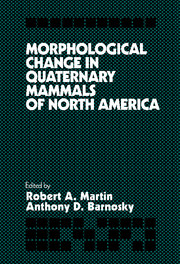Book contents
- Frontmatter
- Contents
- List of Contributors
- Acknowledgments
- 1 Quaternary mammals and evolutionary theory: introductory remarks and historical perspective
- 2 A method for recognizing morphological stasis
- 3 Mosaic evolution at the population level in Microtus pennsylvanicus
- 4 Variogram analysis of paleontological data
- 5 Morphological change in Quaternary mammals: a role for species interactions?
- 6 Rates of evolution in Plio-Pleistocene mammals: six case studies
- 7 Patterns of dental variation and evolution in prairie dogs, genus Cynomys
- 8 Quantitative and qualitative evolution in the giant armadillo Holmesina (Edentata: Pampatheriidae) in Florida
- 9 Evolution of mammoths and moose: the Holarctic perspective
- 10 Evolution of hypsodonty and enamel structure in Plio-Pleistocene rodents
- 11 Patterns of variation and speciation in Quaternary rodents
- 12 Decrease in body size of white-tailed deer (Odocoileus virginianus) during the late Holocene in South Carolina and Georgia
- 13 Short–term fluctuations in small mammals of the late Pleistocene from eastern Washington
- 14 Size change in North American Quaternary jaguars
- 15 Ontogenetic change of Ondatra zibethicus (Arvicolidae, Rodentia) cheek teeth analyzed by digital image processing
- 16 Morphological change in woodrat (Rodentia: Cricetidae) molars
- Index
4 - Variogram analysis of paleontological data
Published online by Cambridge University Press: 15 December 2009
- Frontmatter
- Contents
- List of Contributors
- Acknowledgments
- 1 Quaternary mammals and evolutionary theory: introductory remarks and historical perspective
- 2 A method for recognizing morphological stasis
- 3 Mosaic evolution at the population level in Microtus pennsylvanicus
- 4 Variogram analysis of paleontological data
- 5 Morphological change in Quaternary mammals: a role for species interactions?
- 6 Rates of evolution in Plio-Pleistocene mammals: six case studies
- 7 Patterns of dental variation and evolution in prairie dogs, genus Cynomys
- 8 Quantitative and qualitative evolution in the giant armadillo Holmesina (Edentata: Pampatheriidae) in Florida
- 9 Evolution of mammoths and moose: the Holarctic perspective
- 10 Evolution of hypsodonty and enamel structure in Plio-Pleistocene rodents
- 11 Patterns of variation and speciation in Quaternary rodents
- 12 Decrease in body size of white-tailed deer (Odocoileus virginianus) during the late Holocene in South Carolina and Georgia
- 13 Short–term fluctuations in small mammals of the late Pleistocene from eastern Washington
- 14 Size change in North American Quaternary jaguars
- 15 Ontogenetic change of Ondatra zibethicus (Arvicolidae, Rodentia) cheek teeth analyzed by digital image processing
- 16 Morphological change in woodrat (Rodentia: Cricetidae) molars
- Index
Summary
Since Eldredge and Gould (1972) published their seminal paper on punctuated equilibrium, the field of evolutionary paleontology has been wracked by sometimes bitter disputes over the apparent reality or unreality of evolutionary stasis (Gould and Eldredge, 1977; Gingerich, 1985). Arguments have been advanced for stasis in lineages of protists (Wei and Kennett, 1988), invertebrates (Stanley and Yang, 1987), and vertebrates (Lich, 1990); see Barnosky (1987) and Levinton (1988) for additional references. Many, if not most, studies of morphological stasis in the fossil record have relied on qualitative and/or quantitative inferences about the behavior of location parameters (e.g., means and medians) as functions of geological time (usually estimated from stratigraphic and/or radiometric information). The simplicity and robustness of such tests cannot be gainsaid, but they do leave much unsaid. Figure 4.1 illustrates an artificial data set for which we would fail to reject the null hypothesis of evolutionary stasis when using such statistical tests as the nonparametric runs test (Sokal and Rohlf, 1981) or Lande's (1986) recommended test regarding the overlap of standard deviations about the means. Despite this conclusion we can see an “obvious” evolutionary trend in Z, the variable of interest. An alternative to such procedures is to examine the behavior of dispersion parameters. The purpose of this chapter is to introduce the geostatistical technique of variogram analysis to evolutionary paleontology as a way to supplement location inferences with dispersion inferences, specifically in the case of the Pliocene arvicoline rodent Cosomys primus (Lich, 1990; Anderson, Chapter 2, this volume).
- Type
- Chapter
- Information
- Publisher: Cambridge University PressPrint publication year: 1993

